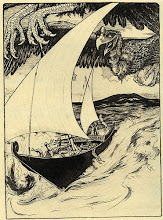A Connection to History:
Before Karel Zeman’s The Adventures of Sinbad the Sailor came out in 1974 in Czechoslovakia, the government and society was at an intriguing time of power struggle and post-war liberalization. In mid-1960s “writers, scholars, and journalists…began denouncing the crimes of political terror and the constraints of censorship.”5 Industry rose as the population became more involved in the government, with many participating in anti-Soviet demonstrations and revolution of communism. The perspective was gradually turning to a near-socialist democracy that granted freedoms of expression that perhaps Zeman took liberty with in his creative animations. Though I didn’t relate any parts of the film to any direct governmental expression, I began to wonder if Sinbad’s burdens were representative of the burden felt by the Czechoslovakian community to conform. It was almost as if Sinbad was the underdog, and though he endured a deal of suppression and obstacle, he maintained strong will and fought for his independence. Maybe Zeman was placing himself as the figure of Sinbad, since he did indeed write the film in such a freestyle manner. The animated characters also reminded me slightly of biblical representations or figures. Perhaps it was simply the style of animation or could be likened to a new-found hope or faith in the society at the time, as they were gaining more of a voice. Religion was a very deep and intrinsic characteristic of the Mediterranean and likely was throughout Europe and the rest of Czechoslovakia.
Subscribe to:
Post Comments (Atom)



No comments:
Post a Comment